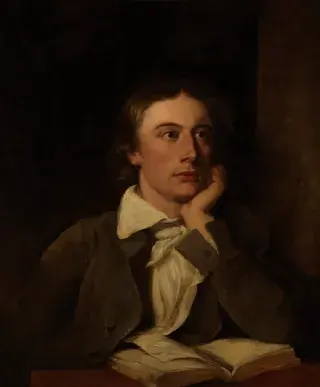Biography of John Keats

| date | place | |
|---|---|---|
| born | October 31, 1795 | London |
| died | February 23, 1821 | Rome |
John Keats, a luminary of English Romantic poetry, was born on October 31, 1795, in Moorgate, London, to Thomas Keats and Frances Jennings. He was the eldest of five siblings, born into a family that, while not destitute, faced financial challenges. Tragedy struck early in Keats's life with the deaths of both his parents when he was just a child. After the passing of his father when he was eight and his mother when he was fourteen, Keats and his siblings were placed under the guardianship of their grandmother, Alice Jennings. Despite the family's financial struggles, Keats received a solid education at the Clarke School in Enfield. It was during his time there that he developed a love for literature and began writing poetry. In 1810, Keats was apprenticed to a surgeon and pharmacist, Thomas Hammond, with whom he studied medicine. However, his passion for poetry soon eclipsed his medical studies, and he abandoned his apprenticeship to pursue a career as a poet. In 1816, Keats became acquainted with Leigh Hunt, a prominent literary figure who introduced him to a circle of writers and intellectuals, including Percy Bysshe Shelley and William Wordsworth. Keats's early poems, heavily influenced by the Romantic ideals of the time, began to garner attention for their vivid imagery, emotional depth, and lyrical beauty. Keats's literary career flourished in the years that followed, marked by a burst of creativity and innovation. He published his first volume of poetry, "Poems", in 1817, which received mixed reviews but hinted at the talent and promise that would later define his work. Over the next few years, Keats produced some of his most celebrated poems, including "Endymion," "La Belle Dame sans Merci," and "Ode to a Nightingale." It was during the spring and summer of 1819 that Keats experienced his most prolific and inspired period of writing. He composed a series of odes, including "Ode on a Grecian Urn," "Ode on Melancholy," and "To Autumn," which are regarded as some of the finest examples of Romantic poetry. These odes explore timeless themes such as beauty, mortality, and the transient nature of human existence, showcasing Keats's mastery of language and his profound understanding of the human condition. Despite his literary success, Keats's personal life was marked by tragedy and hardship. He suffered from poor health throughout his life, exacerbated by the stress of financial instability and the harsh criticism of his work. In addition, the death of his younger brother, Tom, from tuberculosis in 1818, deeply affected Keats and cast a shadow over his own health and well-being. In 1820, Keats's health began to decline rapidly, and he was diagnosed with tuberculosis, then known as consumption, a disease that had already claimed the lives of his mother and brother. Advised by his doctors to seek a warmer climate for the sake of his health, Keats traveled to Italy with his friend, the painter Joseph Severn, in the hopes of finding relief from his illness. Tragically, Keats's condition continued to deteriorate, and he passed away in Rome on February 23, 1821, at the tender age of 25. Despite his short life, John Keats left behind a remarkable body of work that continues to captivate and inspire readers around the world. His poetry, characterized by its exquisite beauty, profound sensitivity, and deep emotional resonance, remains a testament to the enduring power of the human spirit and the transcendent beauty of art. Keats's legacy endures not only in his poetry but also in the profound influence he has exerted on subsequent generations of poets and writers, ensuring that his voice continues to be heard and cherished for generations to come. John Keats, an iconic figure in English literature, crafted a collection of timeless poems that continue to captivate readers around the world. Keats's poetry, characterized by its exquisite imagery, profound emotions, and lyrical beauty, showcases his unparalleled talent and poetic genius. From his celebrated odes such as "Ode to a Nightingale" and "Ode on a Grecian Urn" to poignant narratives like "La Belle Dame sans Merci," Keats's work encompasses a wide range of themes, including love, nature, mortality, and the human experience. Each poem offers a glimpse into Keats's rich inner world, inviting readers to explore the depths of his imagination and the complexities of the human condition. Explore the enchanting world of John Keats poems and immerse yourself in the beauty of his verse. Whether you're drawn to the evocative imagery of "To Autumn" or the haunting melancholy of "When I Have Fears That I May Cease to Be," Keats's poetry resonates with timeless wisdom and universal truths. Discover the enduring allure of John Keats poems and experience the transformative power of his words as they continue to inspire and enchant readers across generations.
Feel free to be first to leave comment.